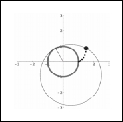47th MMPC Part II Problems
The top 1,013 students had 100 minutes to solve these five problems.
- Consider the equation
x1x2 + x2x3 + ... +
xn–1xn + xnx1 = 0
where xi = 1 or –1, for i = 1,2, ..., n.
- Show that if the equation has a solution, then n is even.
- Suppose that n is divisible by 4. Show that the equation has a solution.
- Show that if the equation has a solution, then n is divisible by 4.
-
- Find a polynomial f(x) with integer coefficients and two distinct integers
a and b such that f(a) = b and f(b) = a.
- Let f(x) be a polynomial with integer coefficients and a, b, and
c be three integers. Suppose that f(a) = b, f(b) = c, and f(c) = a.
Show that a = b = c.
-
- Consider the triangle with vertices M(0,2n+1), S(1,0), and
U(0,1/(2n2)), where n is a positive integer.
If θ is the angle MSU, prove that tan θ = 2n–1.
- Find positive integers a and b that satisfy the following equation.
arctan(1/8) = arctan a – arctan b
- Determine the exact value of the following infinite sum. arctan(1/2) + arctan(1/8) +
arctan(1/18) + arctan(1/32) + … + arctan(1/(2n2)) + …
-
- Prove: (55 +12(21)1/2)1/3 + (55 – 12(21)1/2)1/3 = 5.
- Completely factor x8 + x6 + x4 +
x2 + 1 into polynomials with integer coefficients, and explain why your factorization is complete.
-
In this problem, we simulate a hula hoop as it gyrates about your
waist. We model this situation by representing the hoop with a rotating
circle of radius 2 initially centered at (–1,0), and representing
your waist with a fixed circle of radius 1 centered at the origin.
Suppose we mark the point on the hoop that initially touches the fixed
circle with a black dot (see the left figure). As the circle of
radius 2 rotates, this dot will trace out a curve in the plane (see the
right figure). Let θ be the angle between the positive x-axis and the
ray that starts at the origin and goes through the point where the
fixed circle and the circle of radius 2 touch. Determine formulas for
the coordinates of the position of the dot, as functions x(θ) and y(θ).
The left figure shows the situation when q = 0 and the right figure
shows the situation when θ = 2π/3.
Back to the Spring
Newsletter
This page is maintained by Earl D. Fife

